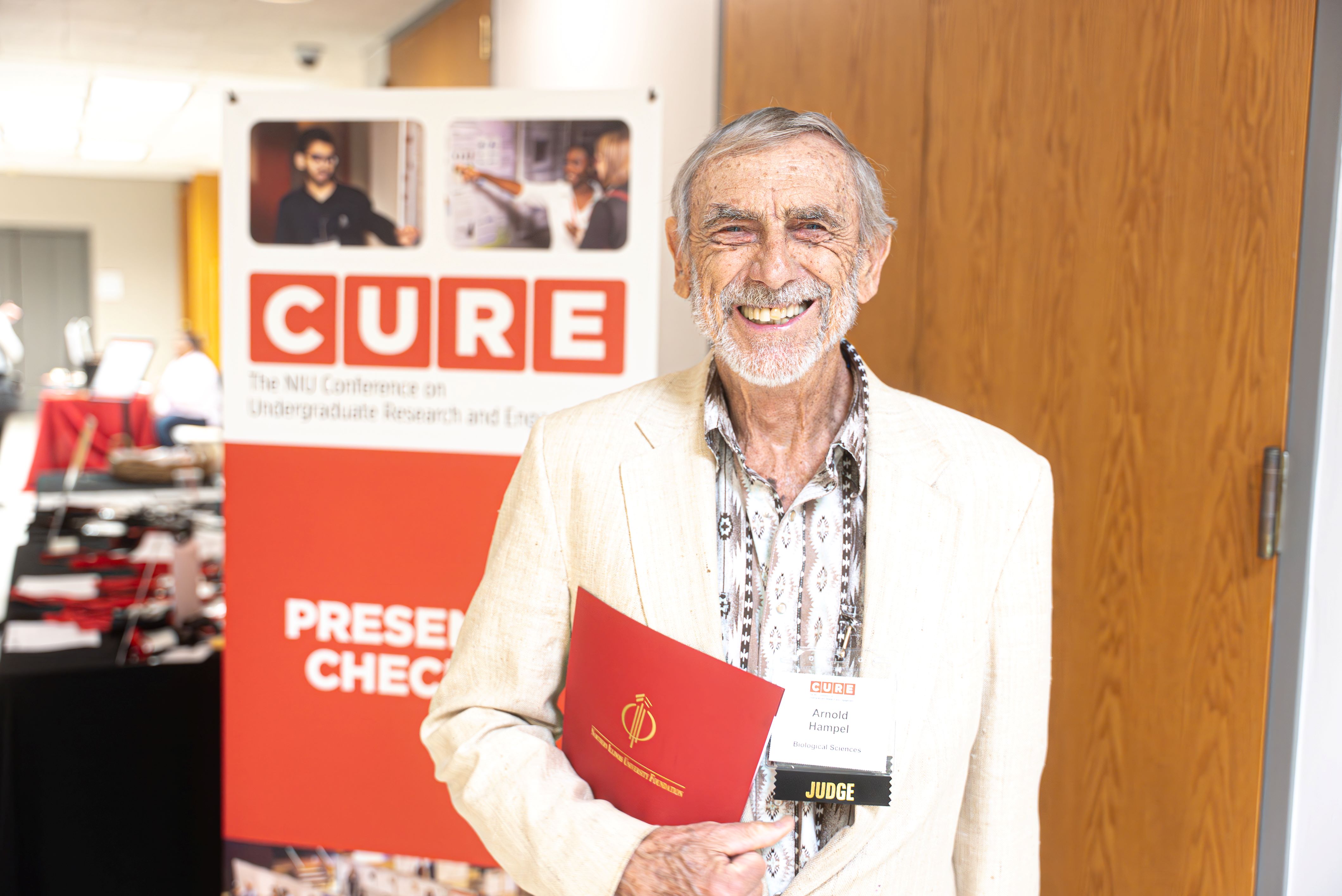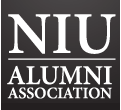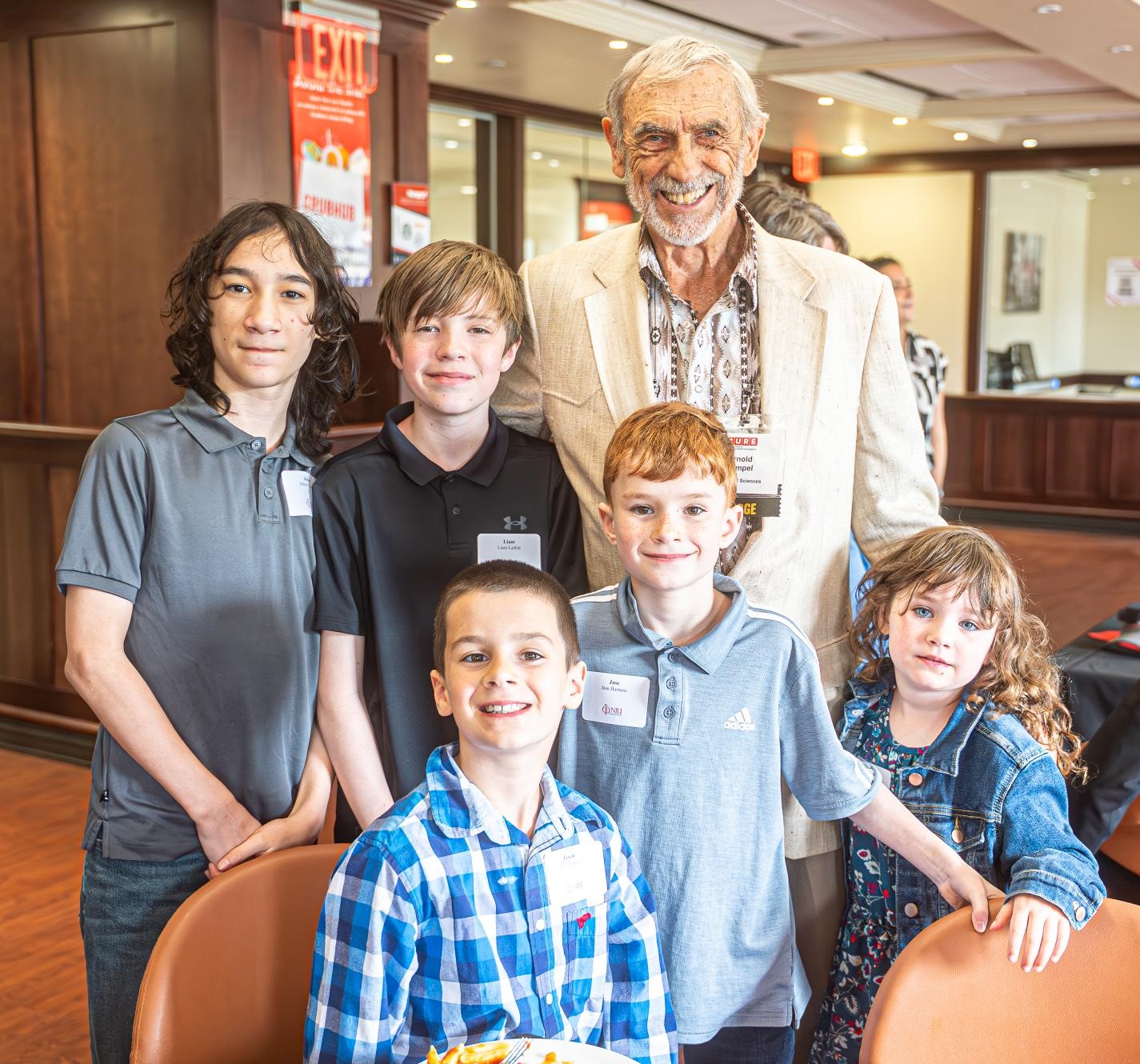CURE Symposium Highlights Student Research Thanks To Generous Philanthropy
By Tony Scott

Dr. Arnold Hampel, '63, at the 2025 CURE symposium. (Photo: NIU Foundation)
For the past 15 years, the Office of Student Engagement and Experiential Learning has hosted the Conference on Undergraduate Research and Engagement, or CURE, NIU’s undergraduate research symposium and culminating event for NIU’s Undergraduate Research Month.
This year's event was especially popular, as it featured the second largest number of projects in its and a 15% year-on-year increase in the number of projects on display, with 220 projects, 277 student presenters and 101 judges.
Students with exceptional presentations receive a monetary award from a fund sponsored through the generosity of former NIU professor Dr. Arnold Hampel, '63, and his late wife, Dr. Denise Kennedy, '84, M.B.A. '95.
At the 2025 CURE symposium, held on April 29, Hampel attended along with some of Kennedy’s great-nephews and grand-niece, who he said were the inspiration behind his giving.
“This is what this is all about,” he said. “My mission is to promote Denise’s legacy and her wishes.”
Hampel, who taught at NIU as a professor in the Department of Biological Sciences and in the Department of Chemistry and Biochemistry from 1970 to 1999, said his philanthropy is an expression of his gratitude to NIU.
“I’m so grateful to NIU,” he said. “I could never thank NIU enough for what they have done for me and my life.”
Students who participate in CURE are profoundly impacted by the experience, and say it gives them a forum for future opportunities..
Last year, Elizabeth Nowak took a first-place award for their presentation, “Stronger Storytelling with Museums and Theatre.” They are a theatre studies and anthropology double major planning to graduate in the spring of 2027.
Nowak plans on pursuing a master’s degree or doctorate in museum studies after graduation and hopes to become a natural history museum curator. They said they began their project in the fall of 2023 as a “research rookie,” with help from their mentor, Jessica Cima.
It takes a lot of work to complete a research presentation for CURE.
“We have asked the question, ‘How can a temporary exhibit impact the audience’s understanding of the play?’ To answer this question, I have curated two exhibits for NIU theatre productions,” Nowak said. “Each round of research takes two semesters. I dedicate the fall semester to planning my approach, establishing contacts and conducting background research. I spend the spring semester curating, installing the exhibit, and collecting and analyzing data. Creating the poster takes about a month. I also spend time practicing how I will explain the process, purpose, data and conclusion.”
One of this year’s winners, Willow Phipps, presented “Detecting Storm Mode with Machine Learning.” A transfer student from Illinois State University, Phipps graduated from NIU in May 2025 with a bachelor’s degree in meteorology and aims to become a researcher, professor or National Weather Service employee.
“No matter what, I want my career to focus on public service or education,” Phipps said.
Phipps’ project was a collaborative effort with their research partner, Brandon Weart, where they trained a convolutional neural network, or CNN, a type of machine learning model, to detect storm morphologies using radar imagery.
“The shape of a storm can tell us a surprising amount about what type of hazards are most likely to occur and can be surmised by radar imagery that essentially detects the ‘intensity’ of precipitation,” Phipps explained. “Our work resulted in overall accuracies of around 83 percent, which are higher than other machine learning models outside of CNNs, but previous work by a student here at NIU, Jeremy Corner, demonstrated a much higher ceiling for morphology detection using CNNs, around 97 percent.”
First-place winner Stacey Marcinkowski, an environmental science major with a focus on biodiversity and conservation and a minor in biology, presented “Flying Safe: Reducing Bird Strikes at Northern Illinois University.”
“The goal of this project was to identify high target areas for bird strikes around NIU,” she said. “Once we did that it was the goal to find cost alternative methods to mitigate bird strikes, especially during migration season. That is when window markings were applied with markers; the preliminary results showed that the method would be effective.”
Vana Dakarian, a double major in biological sciences and public health, received a CURE award for her presentation, “Flotillin 1 is Required for the Polarized Deposition of Basement Membrane Proteins in Epithelial Cells.” Dakarian hopes to become a physician.
“My project is focused on epithelial cells, one of the most abundant cell types found in humans,” Dakarian explained. “Epithelial cells are characterized by their organized architecture. The basement membrane is an essential component of epithelial architecture that lines one side of epithelia. The follicular epithelium of the Drosophila melanogaster, or fruit fly, ovary is our model system for studying the epithelial polarized architecture and the secretion of basement membrane proteins.”
She continued, “We are researching Flotillins — well-conserved genes involved in proper placement of basement membrane proteins secreted by epithelial cells to form the basement membrane. We identified Flotillin 1 as having a significant role in basement membrane protein secretion. This project sheds light on the mechanisms important for proper basement membrane placement and epithelial architecture, which will impact understanding of various diseases caused by the loss of epithelial structure in humans, such as cancers.”
The students interviewed were grateful to Hampel and Kennedy, and for the CURE experience.
“I never thought that I would be a winner of an award, and I am truly thankful and humbled that my judges gave me such high marks,” Marcinkowski said. “It has given me a major confidence boost in my ability to conduct the research and present it. I feel extremely confident moving forward that I will be able to successfully research the next topic of my choosing.”
Marcinkowski thanked her mentor, Jennifer Koop. Dakarian thanked her mentors as well.
“I wasn’t expecting to win anything, so it was a surprise and honor to have received this award,” Dakarian said. “When I first joined this Biological Sciences lab as a freshman, I was overwhelmed by everything I had to learn. My faculty mentor, Olivier Devergne, and graduate student mentor, Hemin Shah have supported me immensely during the past two years and helped me grow as a researcher. Receiving this award felt like a recognition of all the growth I’ve had and the effort I’ve invested into this project.”
The students expressed that CURE will mean greater professional and academic opportunities in the future.
“I was thrilled to win a CURE award as a first-year student and researcher, representing both anthropology and theatre,” Nowak said. “This will help me be a better candidate for interdisciplinary research positions, museum internships and graduate programs. Already, the award stands out on my resume, and I have since presented at a talk, and will be interning at the Pick Museum of Anthropology this fall.”
Marcinkowski said, “Symposia such as CURE are extremely important, as they give students an opportunity to connect with professors for potential research opportunities. It is also an opportunity to present unique research that, if it is what we want to continue with in the future, can connect us with a professor who may also be interested in the same area and be willing to take us on as grad students and help get funding to further the research.”
Phipps saw CURE as an opportunity to sharpen their professional and research communication skills.
“It affirmed my goals in becoming a professional researcher in the future and made me excited to go to graduate school to pursue a project that I am passionate about,” Phipps said. “In my opinion, research opportunities like CURE are extremely important for undergraduate students who want to pursue academia or higher education, because talking and networking with professionals at a conference is a necessity for a successful career in the field.”
Dakarian said research is an excellent opportunity for students, and CURE gives students a needed platform.
“Research reinforces content from the classroom, enhances critical reasoning skills, and allows students to experience being on the cutting-edge of a field,” she said. “Conferences like CURE provide a platform for students to share their research with the greater community, which I found to be exciting and empowering.”

